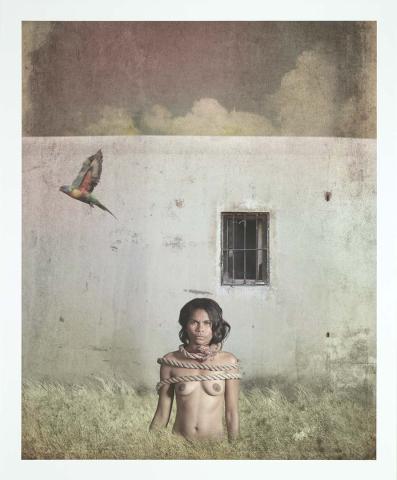COOK, Michael; Broken Dreams series
Michael Cook’s photographs have become well known for a whimsical and unique interplay of surrealism and political potency. The ‘Broken Dreams’ series 2010 was one of the Queensland Indigenous photographer’s most important breakthrough works, produced in the first year of his artistic practice. Coming from a commercial background, Cook had long entertained moving into art photography and had been incubating many ideas before his career change. When Cook took the leap into contemporary art practice it was marked by a rapid outpouring of work, with six major photographic series completed within his first two years, some of which — ‘Through My Eyes’ 2010, ‘Undiscovered’ 2010, ‘Broken Dreams’ 2010 and ‘Civilised’ 2012 — are among the most iconic image suites in contemporary Australian art.
This rapid yet resolved release of work allowed for a clear view of Cook’s practice from its inception, something not usually evident until several years into most artists’ careers. In Cook’s case, it gave a window into another world — an all-Aboriginal world — where Indigenous protagonists play every role, from the coloniser to the colonised, and from first contact to the present day.
In ‘Broken Dreams’, Cook introduces us to one of his dreamlike narrative sequences in which he implicates a young Aboriginal woman. The woman imagines what life was like for the female British colonists she encounters along the frontier; she fantasises about being in the shoes, and clothes, of those at the other end of the social class spectrum. The first two images in the series of ten depict the woman in London along the River Thames in front of Westminster and Tower Bridge, both symbols of the power and might of the British Empire. Here she projects an air of being free, resplendent and important. In the third image she poses in front of a tall ship, implying the start of her voyage to Australia. As the series unfolds, the woman is successively disrobed — her Victorian dress replaced by ropes that appear to shackle and restrain her — in scenes that connote peace, war, religious indoctrination, exploration, bondage, incarceration and perhaps death, as her fantasies unravel and her dreams are broken. ‘As her journey progresses, so does her realisation that their culture is not her culture,’ writes Cook. ‘As time passes, she sees the impact these new settlers are having on her people.’(1)
Throughout the series, the woman is accompanied by a single rainbow lorikeet. Its presence is slightly unnerving, its role never entirely clear; like the wild lorikeet, its intentions are hard to read. Cook's dream-journey explores the tension between the freedom of the colourful bird and the muted dresses and dreams of its female human counterpart. The lorikeet gradually reveals itself as the embodiment of the woman’s spirit, a symbol of the freedom for which she yearns but can never grasp — this new colonial life is being built for her by powers half a world away. ‘Dreams broken, hopes replaced with despair, she begins to shed her newly-clothed skin and returns to her roots to find freedom — the connection back to her land.’(2)
In the final image, the heroine is pictured in a field of tall grass, naked save for the heavy rope — now wrapped around her arms and neck — held taught above her head by her parrot accomplice. Cook describes this image as a ‘freedom’ and a return to her country.
Yet her return is countered by the weight of her ropes, in places doubled over as if tied like a noose. The lorikeet appears to be at once carrying her away and also tightening the rope around her neck. Although her dreams of grandeur are dashed, another more devastating realisation occurs in the final image, as the bound Aboriginal protagonist realises the impossibility of returning to a pre-colonial world. Her every dream of escape is broken.
And yet the lorikeet — representing her spirit, her hope, her dreams of or for a better place — still flies.
Bruce Johnson McLean, Artlines, no.4, 2018, pp.54–5.
Endnotes
1 Michael Cook [artist’s statement], viewed September 2018.
2 Cook [artist’s statement].
Connected objects

Broken Dreams #10 2010
- COOK, Michael - Creator

Broken Dreams #9 2010
- COOK, Michael - Creator

Broken Dreams #8 2010
- COOK, Michael - Creator

Broken Dreams #7 2010
- COOK, Michael - Creator

Broken Dreams #6 2010
- COOK, Michael - Creator

Broken Dreams #5 2010
- COOK, Michael - Creator

Broken Dreams #4 2010
- COOK, Michael - Creator

Broken Dreams #3 2010
- COOK, Michael - Creator

Broken Dreams #2 2010
- COOK, Michael - Creator

Broken Dreams #1 2010
- COOK, Michael - Creator